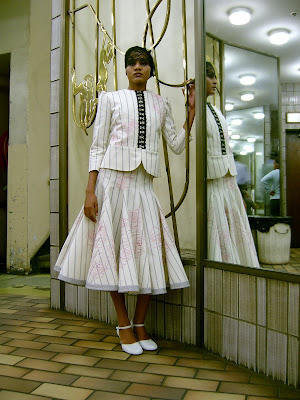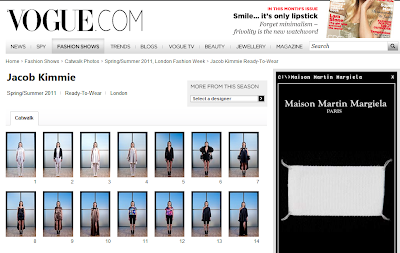JACOB KIMMIE
Friday, 11 July 2014
Monday, 22 November 2010
Archive: jacob Kimmie did Colour, 2003 - 2005






Archive: yellow crochet dress, square vintage sequins, 2003
Archive: Johannesburg Photoshoot, 2005






This is one of the last shoots that I done of one of my collections back in South Africa. The photographs were taken in a glorious Art Deco building that now houses squatters and an HIV/AIDS clinic, and is also where the little clothing manufacturers (comprised of 4 women in their 40s whom decided to club together and form their own business. Two of them have subsequently passed away from cancer and HIV-related illnesses) is based. Nonthlntha, the model speaks hardly any English and has never modelled before. If you look carefully, catch a glimpse of James in the mirrors taking the pics on an antique digital camera! These were the fun days.
Sunday, 21 November 2010
Thursday, 21 October 2010
A conversation with fashion designer Jacob Kimmie by Samantha Barker

I discovered your work through a good friend of my sisters who modeled for your 2011 Spring/Summer ‘Eternal Delight’ presentation at this year’s autumn London Fashion Week. The striking image of the cobalt blue wool suit that had such beautiful and compelling tailoring captured in the static image of a model, captured my imagination and I wanted to know more…
I wanted to hack away at the jacket, create a type of blueprint for a new, unfussy, un-over-worked form of tailoring. The colour is quite modern, evocative. The blue version "feels" very different from the black, which feels a little more severe...sexy even.
You were born in Johannesburg, South Africa, on your website it is detailed that ‘anger and injustice’ drives you in your work as a designer. How does this drive you? – Anger and injustice against you and close loved ones or an issue that affects you and wider public as a whole? Please explain.
I grew up in the township streets of Apartheid South Africa. My background, I guess, plays a big part in the way I think about creativity. Perhaps, what I was exposed to - the unrest, poverty, the sensless violence... it strips away your inclination for self expression, and replaces it with something else. When I was growing up, there used to be military vehicles, an armed military, patroling our township roads. That fucks with your head. I dont' think that it surpressed my need to create. If anything, it made me want to, even more. Something happens to you when you have to fight for freedom. I think it power-charges your emotions and radicalises your vision. I'm wired to a different kind of baggage, a different kind of bullshit. Note that I'm driven by anger...my works not about anger...
What age did you come to the UK? Did you design whilst in Africa and does this still have influences on your design work?
I came to the UK for the first time when I was 26 on a working holiday visa. They were the two best years of my life in London.Till then, I had freelanced as an illiustrator, then as a stylist and writer for The Star newspaper (when I was 21), supplied rave boutiques with plastic dresses and had my first label called Chromosome fitting dresses to women by the age of 26. That time especially will always have an influence on my work. Determination is a bit like respect- you don't just get it...you earn it. Aesthetically, now, I'm a little more grown-up and a little bit more bald.
When and why did you start fashion?
I don't know. I can't recall the first time I picked up a needle. I've always been "stitching" (you should see my blind stitch). My aunts all worked in dress factories, but could never afford the dresses they used to work on. So, they would on a Friday evening buy fabric remnants in downtown Joburg and recreate the dresses to go out dancing in. They could make those dresses in a day. All this would happen with me sitting under the table making dresses for my cousin's dolls with the off-cuts, much to my dad's horror. I think it's where my affair with fashion really began, and where the escapist-like exagerated romantic effect took form that I think my work is about.
How does the UK compare to Johannesburg for creative opportunity?
It doesn't. You can't compare the two. Johannesburg is brown, dirty, edgy, hostile, exciting and grim. Life is plentiful, but cheap. London is grey, nostalgic, lose, perverse, tribal, contradictory, dynamic, prim and vile. People care better for their animals than their old. They are about different romances...different visions. That's what makes it exciting for someone like me to show in London. My look is dangerously at odds with that prim London establishment. They can't stick a label on me, a bit like my race. South Africa struggles with the possibility of the future, while the UK is obsessed with nostalgia. My colonialist background pitched againsts the UK's struggle with globalisation is the honey-pot of my thinking.
At your ‘Pilgrim’ show for Autumn/Winter 2010, you featured a baby, why did you decide to do this? You again showed your open - minded and innovative approach to models, by incorporating a male model with the lower part of his arm missing in your Spring/Summer 2011 presentation. Is this becoming a purposeful statement by you as a designer; to go against the idea of what is ‘normal’ to see in high fashion catwalks/presentations - is it part of the story you are telling, an added social narrative and statement running through the collections?
I dont go against the idea of what is normal. That's a tacky cop-out for being original. I wasn't the first to use a baby or a model born with a congenital birth defect. They're simply accentuate the otherliness of my muse, and sometimes they are lingered with esoteric pepperiness.
‘Eternal Delight’ which is taken from the William Blake plate "Energy is eternal delight. He who desires but acts not breeds pestilence’, is the title of your Spring/ Summer 2011 collection. I thought it was intuitive and clever to capture this ‘energy’ by having the models stand statically, with fans showing movement of the garments against the model’s bodies. It allowed the clothes almost to be viewed mid motion, as if you’d stopped them midway down a catwalk – capturing a special moment and allowing fashion’s blessed to view it close up. Do you agree with this statement?
You have collaborated with jeweller Ginta Siceva, on the ‘Pilgrim’ (A/W 2010) collection and Kate Mead in 2008, for two dresses entitled the ‘Bullet’ and the ‘Marble’ dress. How do you find collaboration contributes to your own thought processes as a designer? Is it a valuable experience?
High fashion is about possibilities. What use is an idea if I can't create it? And sometimes others might be better at it than me. Collaborations are about over-lapping egos. To make that work, you have to completely trust your motives and be genuine about sharing the spot-light with another. I have no problem with that. Ginta and Kate are incredible to work with. Above everything else, they are fantastic confident resourceful women...and Ginta always looks amazing at the show.
After running a ‘Live’ competition with Birmingham City University, you chose two students to design the jewellery pieces for the ‘Eternal Delight’ collection. It must be fantastic for the students involved - offering them a glimpse of what they could achieve when professional, and especially for Alice Welsh and Fiona Maria Ross who worked with you on the final pieces. Did you enjoy and benefit from this?
The live project was great. I was really keen to see "design training" up close. The future doesn't look too grim.
Do you feel you are at an advantage from not going to university? Would you recommend others who wanted to start a career in fashion to be confident in taking a route of their choice and that, that route doesn’t have to be university?
I'm passionate about education, but i dont get the point about degrees or masters degrees in fashion. Nearlly all the graduates I've met can't make a finished dress. If they could, the proof would be in the pudding- they'd all be slightly better off than unemployed because they would have figured out that if you can make a basic shift dress, you can eat. I secretly wish that I went to university. I'm one of those types who would have worn something to piss-off the dean...like Vivienne Westwood without knickers when she met the queen. Students don't have the pluck for that kind of thing anymore. They dont see the end result of learning as a form of fun. They paralysed by dissillusionment and tacky pop music. Also, this year, I met 9 students who are dyslexic.
To intern at Jacob Kimmie, its compulsory to have a part time job and to agree to everything I say. Those who succeed at the interview get to draw porn. The results have been mind blowing.
Have you had any favourite, defining, even life- changing pieces that you have designed?
I've had many, since many of the pieces in the shows, I make the patterns myself. The stand out piece would be a tulle and wool crepe camisole from my SS10 La Fille Sauvage collection. It was intended to be a showpiece only, but ended up being ordered all over the middle east including D'na, the concept store in Riyadh. There isn't a single bone or closure in the piece, yet it fits like a dream, cut on the bias.
Do you admire/ are inspired by any other creatives and why? (Across fashion, interiors, photography, craft ….)
My collections always start with music. Music sets the mood...the tone for my collections. For AW1011 for instance I heard a remix of John Cutler's It's Yours and it instantly evoked temples and ritual...in a house music club! It puntuated the urban-tribal glances in my work. I'm drawn to the work of photographers like Pieter Hugo and musicians like Amon Tobin. And I absolutely love Die Antwoord. I would...they make everything else in art and music seem completely banal.







































